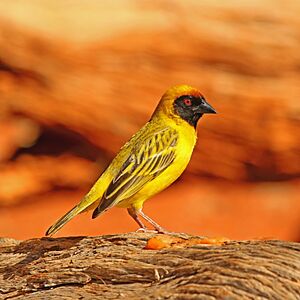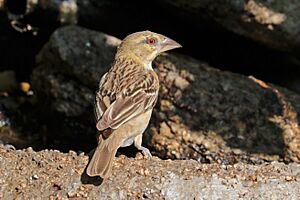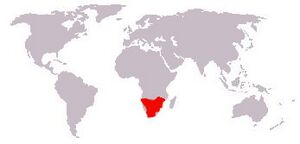Southern masked weaver facts for kids
Quick facts for kids Southern masked weaver |
|
|---|---|
 |
|
| Male, Tswalu Kalahari Reserve, South Africa | |
 |
|
| Female, Erongo, Namibia | |
| Conservation status | |
| Scientific classification | |
| Genus: |
Ploceus
|
| Species: |
velatus
|
 |
|
| Range | |
The southern masked weaver (Ploceus velatus) is a small, bright bird. It is also known as the African masked weaver. These birds live and breed all over southern Africa.
You can find this type of weaver in many different places. They live in bushy areas, savannas, grasslands, and open woodlands. They also like wetlands and semi-desert spots. Sometimes, you can even see them in gardens and parks in towns.
Contents
About the Southern Masked Weaver
The southern masked weaver is about 11 to 14.5 centimeters (4.3 to 5.7 inches) long. It has a short, strong beak shaped like a cone. Its legs are pinkish-brown.
What the Male Looks Like
When a male weaver is ready to breed, it looks very colorful.
- Its face, throat, and beak are black.
- It has bright red eyes.
- Its head and belly are bright yellow.
- Its back is a plain yellowish-green.
What the Female Looks Like
Female weavers are not as bright.
- They have a pinkish-brown beak.
- Their eyes are brown or reddish-brown.
- Their bodies are a dull greenish-yellow.
- They have darker streaks on their upper back.
- Their throat is yellowish, fading to off-white on the belly.
Young Birds and Calls
Young southern masked weavers look like the females. Males that are not breeding also look similar to females, but they keep their red eyes.
The call of this bird sounds like a harsh "swizzling." It is similar to the calls of other weavers. When there is danger, they make a sharp "chuk" sound.
Weaver Behavior and Life Cycle
Nest Building and Reproduction
Southern masked weavers build their nests in groups called colonies. They usually do this from September to January. Male weavers often have several female partners. Each male builds many nests, sometimes up to 25 in one season!
Their nests are woven from reeds, palm leaves, or grass. They are very strong. A female will choose a nest and then make it cozy inside. She adds soft grass and feathers. Weavers often build their nests in trees, especially over water. They can also build them in reeds or even in suburban areas.
Weaver birds lay eggs that come in many different colors. This helps them protect their eggs from cuckoos. Cuckoos are birds that try to lay their eggs in other birds' nests. Because the weaver's eggs are so varied, the cuckoo doesn't know what color to expect. If a cuckoo lays an egg of the wrong color, the weaver parents will push it out of the nest.
How They Find Food
You usually see southern masked weavers alone or in small groups. Sometimes, they gather in larger flocks. They might even join other birds that eat seeds.
These birds eat insects, seeds, and nectar from flowers. They are also happy to visit bird feeders in gardens.
Images for kids
-
Nesting colony, Kruger National Park
-
Male starting to build nest, Johannesburg
-
Male building nest, Johannesburg






